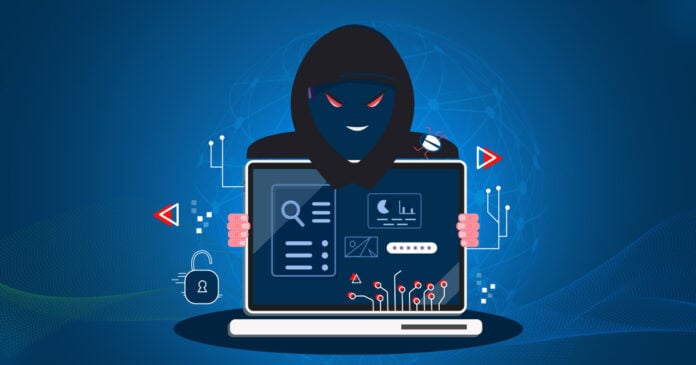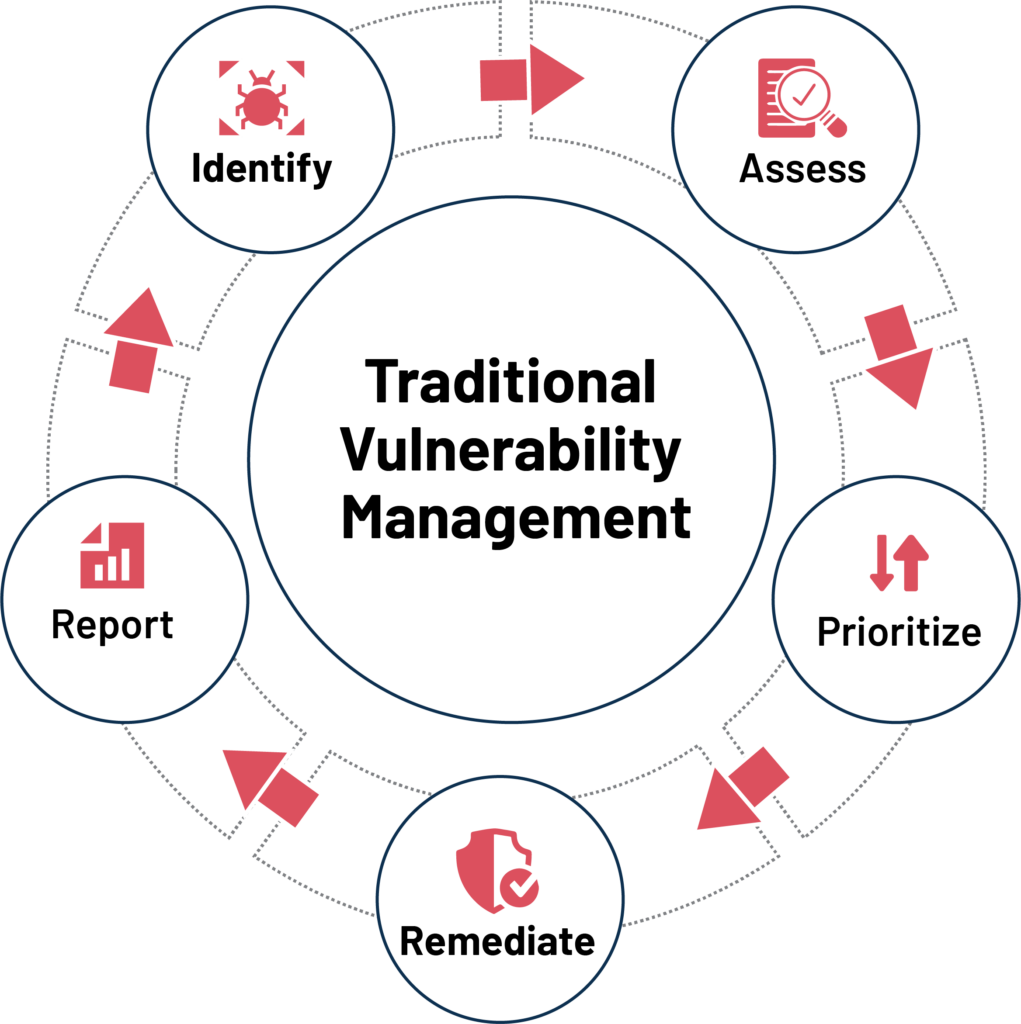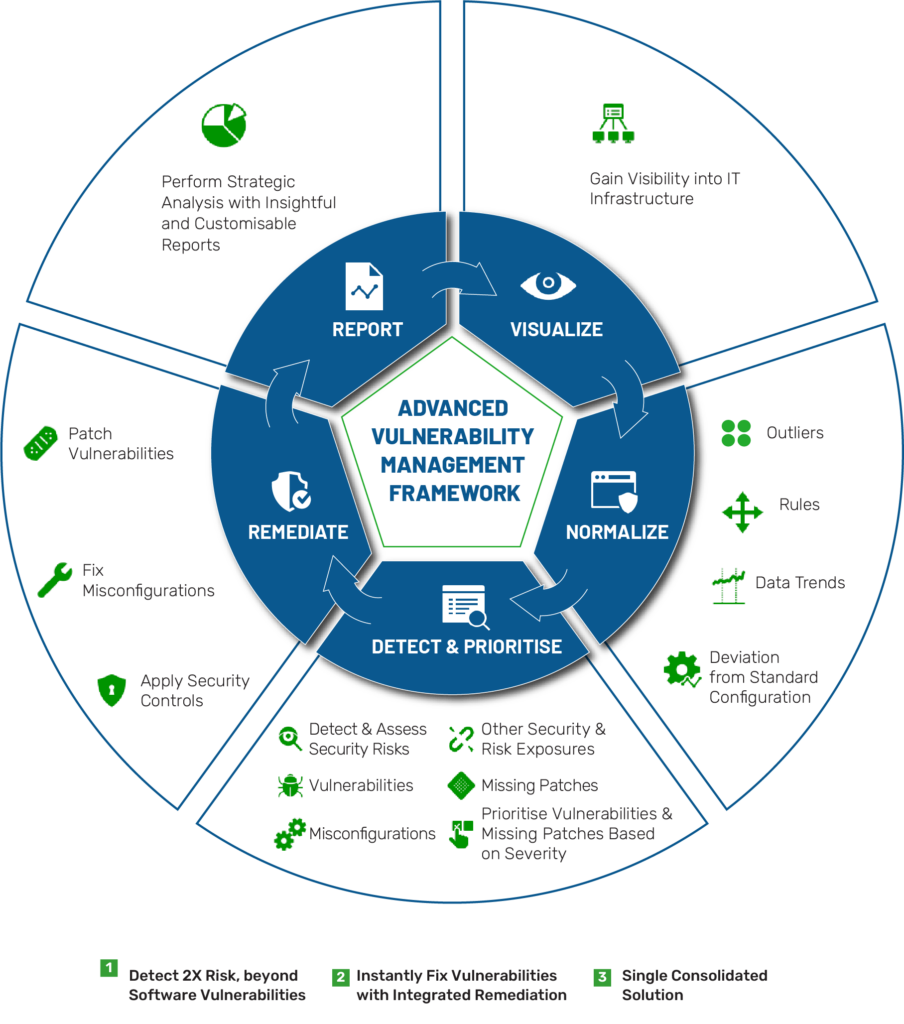

The shifting landscape of cybersecurity poses significant challenges for traditional vulnerability management approaches. The difficulties often arise from a lack of automation and a compartmentalized “silo” approach. Unfortunately, the full potential of modern, sophisticated vulnerability management frameworks is yet to be realized across the industry, leaving some room for cybercriminals to exploit.
According to SecPod’s research, software vulnerabilities account for about 56% of the risk landscape. That means 44% of vulnerabilities remain unaddressed by traditional cybersecurity trends. The limited scope of traditional vendors and a lack of knowledge on the current state of cybersecurity leave gaping holes in risk assessment.
The primary goal of modern Enterprise IT Security teams is to stay safe from cyberattacks, but they can only do so much with traditional tools and resources. The only way to secure modern environments is to rapidly eliminate cyberattack surfaces and achieve a high level of effectiveness in their vulnerability management efforts.
In this article, we will dive into the existing state of vulnerability management, exploring its challenges and implications on cybersecurity. We will scrutinize the limitations of traditional vulnerability management processes, while also highlighting how advanced frameworks can foster growth and resilience in the industry.
The 5 Stages of Vulnerability Management
A vulnerability management vendor provides a solution that identifies, evaluates, mitigates, and reports on security issues and vulnerabilities across a client’s network. This is achieved with a range of processes, scanning tools, and techniques, providing a real-time overview of how secure an organization’s digital environment is.


The vulnerability management process can be typically broken down into five stages.
- Discovery – Detecting vulnerabilities is the first stage and this is achieved by performing regular network scans (internally and externally). Scanning also includes identifying open ports and checking any network-accessible systems. The findings are typically cross-checked with a database of known vulnerabilities.
- Assessment and Prioritization – Most modern vulnerability platforms provide metrics that can be used to rank the threat level of any discovered vulnerabilities, but context also needs to be considered to assess the overall risk to a specific business.
- Mitigation/Remediation – Once any vulnerabilities have been identified, recorded, and assessed the next step is to mitigate any risk they pose. To do so, the solution must create and enforce a strategy to remediate vulnerabilities with patches or other means without adversely affecting the organization’s work output or productivity.
- Verification – Once a strategy to mitigate any risks has been created, checks must then be made to verify that the necessary actions have been carried out. This is usually achieved by running another network scan.
- Reporting – Finally, a report containing the details of the initial scan, its findings, and how any vulnerabilities were addressed is compiled. Report generation is often automated using a management platform.
The Disadvantages of Traditional Vulnerability Management
Unfortunately, there are still a large number of vulnerability management platforms that have not modernized sufficiently, effectively aiding cyberattacks due to a lack of visibility. As cybercriminals constantly adapt to the changing digital landscape, so must vulnerability management vendors if they wish to protect their clients.
A cyber attack can not only involve financial implications but can also cause long-term damage to a business’s reputation. That’s because a cyber-attack that results in customer data being threatened or stolen will almost certainly result in negative publicity, from negative reviews to affected customers speaking openly on social media.
And while some negative reviews can come from a misunderstanding with the customer, those situations can sometimes be rectified. A cyberattack that results in customer data being lost, however, is not a rectifiable situation. At the end of the day, a poor public image can be sometimes irreparable.
Failing to replace limited software, fragmented teams using different tools, and ineffective flow of information are some of the main reasons for the downfall of traditional vulnerability management. Many organizations default to a workflow that is separated by data silos, applications, and personnel.
For example, traditional vulnerability management processes start with a vulnerability scanner. The scanner generates a report for analysts to hand off to patch management teams. These teams use various tools to define and segregate vulnerabilities before passing the results of their findings to be remediated or mitigated when appropriate. Testing and deployment follow, and then the cycle starts over again.
The old method leaves too much room for error, miscommunication, and takes too much time to be effective against modern cyber threats. Minimizing organizational risk requires vulnerability management tools built with everything necessary to assess security controls.
Below are some of the key disadvantages of outdated vulnerability management processes.
- Limited visibility – Traditional vulnerability management tools only seek visibility of high-level info on software and hardware components. Advanced platforms provide deep visibility into outliers, anomalies, and trends so that teams have enhanced confidence and clarity in the effectiveness of their security posture.
- Long Scans – By not using advanced scanning tools, network scans can take a very long time, delaying any exposures from being discovered and remedied. Advanced platforms offer fast results so that Enterprise IT Security teams can protect their systems with improved efficiency.
- A lack of integration – A traditional approach means there is often a lack of integration in terms of how best to mitigate a vulnerability. This can often result in long delays, meaning a network can be left exposed for months at a time.
- Too much focus on common vulnerabilities – Traditional tools and processes are too focused on common vulnerabilities and exposures (CVEs), resulting in newly developed exploits and less known vulnerabilities going under the radar.
- Reliance on multiple tools – The large number of tools used by traditional vulnerability management vendors can make correlating findings difficult during the assessment and mitigation stages.
- Reports are not concise – A lack of automation means reports can often be convoluted, containing results from several different tools. This means they can often be difficult to read for the client.
Advanced Vulnerability Management Framework


Moving to an advanced vulnerability management framework helps to solve three key problems that can be summarized into questions that organizations need to ask themselves.
- Are we uncovering the entire risks in the IT security landscape?
- Is vulnerability assessment integrated with vulnerability remediation?
- Are vulnerabilities continuously and automatically managed from a single console?
If the answer to any of these questions is no then it is time to reconsider your cybersecurity solutions going forward to ensure you are getting the full protection your organization needs.
With an advanced framework, the entire vulnerability management process can be controlled and executed by a single console, meaning each component is fully integrated and resources are not stretched. This automated and less resource-heavy approach also means that the discovery process can go beyond identifying just CVEs.
Remediation is not subject to any delays, with any vulnerabilities mitigated on-time with integrated mitigation controls. The automation of end-to-end tasks also helps to develop a continuous routine, meaning scans and assessments can take place regularly with minimal preparation.
Some platforms also utilize machine learning to further improve the scanning and discovery process. This is thanks to strong developments in terms of ML being utilized for internal processing automation, which is one of the leading use cases of ML for businesses with nearly a third of business owners who utilize ML using it for this purpose.
Future Challenges for Enterprise IT Security Teams
Although advanced frameworks have helped to modernize vulnerability management to automate tasks and improve the effectiveness of processes, the industry still faces challenges that Enterprise IT Security teams need to consider before choosing a vulnerability management platform.
Organizations are increasingly seeking vulnerability management tools that come with configuration management features as well. Many traditional vendors are not meeting these evolving needs, leaving Enterprise IT Security teams to build their own tools or outsource vulnerability management.
Additionally, Security teams have an increased need for container security features for every infrastructure layer. Containers and kubernetes have become essentials for modern DevOps frameworks, so containerized features are likely to become a key component of vulnerability management. Many traditional tools don’t include features such as container vulnerability management and scanning.
Another challenge is the cost of automation which can sometimes result in businesses opting for a cheaper, traditional vulnerability management approach. To manage these costs, an organization needs to prioritize what assets are the most vital to protect, helping them balance automation costs.
Finding the right vulnerability management platform for modern enterprise infrastructure is a challenge in itself.
Conclusion
Advanced vulnerability management frameworks greatly improve the processes and approaches of traditional vulnerability management for Enterprise IT Security teams. Traditional vendors are hindered by a lack of visibility across the network, resources, and integrated tools, as well as only focusing on common vulnerabilities and exposures – to name just a few issues.
Modern vulnerability platforms, on the other hand, offer Security teams unparalleled visibility and insights to eliminate the cyber attack surface and achieve security effectiveness across the organization.




















